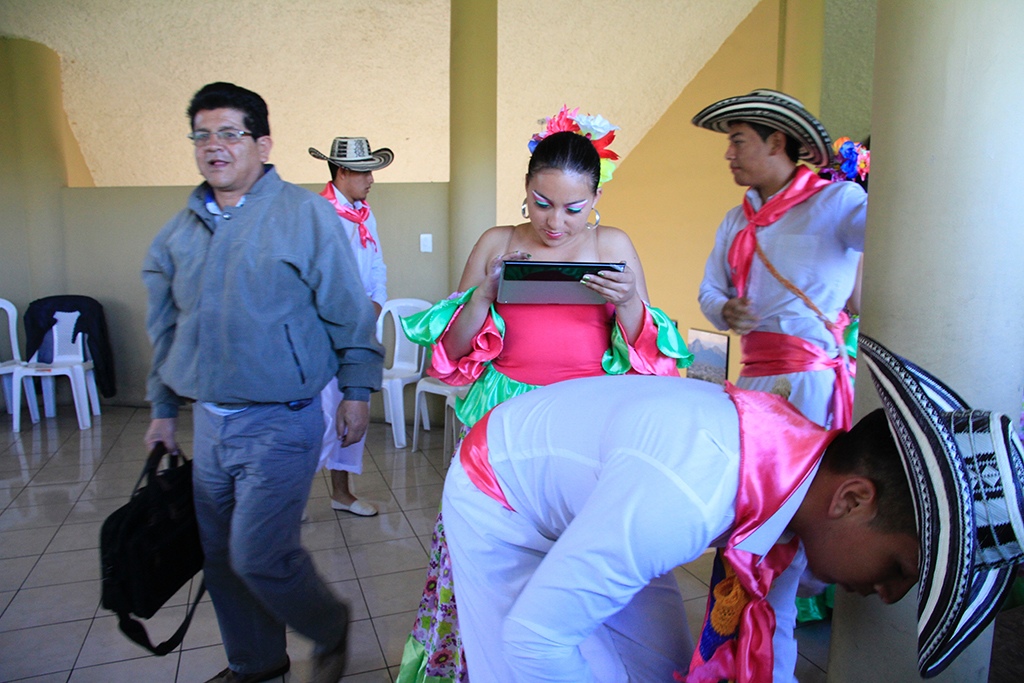

July 25th. We move slowly along Mariscal Sucre Avenue in Anapau’s enormous Volvo 850 family car. The traffic is especially heavy at this hour in the south of the city. We will arrive more than half an hour late. In the Ortega ravine, a large group of neighborhood representatives from Quitumbe awaits us. Upon arrival, we apologize profusely for the delay. They very kindly do not take it into account.
We have previously coordinated the meeting with Fabián Melo and Sandra López, and its purpose is to share the work processes of the project
Bellvitge live role-playing
on our part and for them to explain to us what initiatives they wanted to promote in the Quitumbe neighborhood, in order to think together how they could be developed.
Talking about Bellvitge live role-playing in this context was relevant since one of the group’s concerns was precisely neighborhood memory. Thus, after explaining what Bellvitge live role-playing consists of and how we had addressed the issue of memory in this project, an interesting debate took place in which we analyzed and discussed some of the problems that would go through any future development of work on memory in Quitumbe and the Ortega ravine.
Although the purpose of the meeting was not, of course, to start building a historiographical account of the neighborhood, some data inevitably appeared that needed to be taken into account: above all, it should be noted that the neighborhood is very young, with only 23 years of history.
Soon a question arose that the collective considered necessary to consider: the way in which individual memory relates to collective memory. It was pointed out that the life stories of the residents coincided in a historical moment: when they buy the plot of land and become part of the
As we said in the previous chronicle, one of these factors that the residents faced was precisely the majority tendency to cover the ravines. The decision to recover the ravine as a natural space went against what common sense and the uses of that moment dictated and involved a genuine exercise in divergent thinking that made it possible to build a habitat that relates harmoniously to the territory instead of imposing itself on it.
Something that seemed especially noteworthy to us is that all these processes can be understood in a pedagogical key, insofar as they brought about a large number of significant learning experiences for the community. Of all of them, perhaps the most important arises from the question of
All this baggage is part of the heritage of the ravine, of its memory and its culture, and in some way ended up being linked during the conversation to the project of a Community Development Center. In the implementation of this center—which for the moment is nothing more than an idea—it was wanted to give a leading role to young people, as a generational relay of neighborhood movements in the ravine. In this direction, the

The creation of a Community Development Center gave rise, on the other hand, to thinking about public policies: The self-management tradition of the ravine seemed to conflict with state policies, which were seen as a form of control over communities; among other reasons because the state arrogated the production of Good Living: it is the state that gives Good Living and who defines what is or is not Good Living.
The Community Development Center was seen as a necessity in the process of habitat development and construction and learning of the cooperative, in which new spaces for dialogue and coexistence, popular education and situated communication projects such as a digital newspaper could be opened.
At one point in the conversation, Fabián Melo spoke of the need for a «civilizational change» that would involve a break with established forms of relationship with the habitat. Here it seemed relevant to point out how the cooperative tradition of the ravine could be applied to forms of solidarity economy and responsible consumption beyond housing.
Finally, there was talk of how the possible involvement of experts and professionals should take place in any collective creation project. Here, the memory of the role of architects in the design of the ravine’s homes served as an example to address the issue. This point was especially relevant given the involvement of the community mediation team of the
Museums of the City Foundation
(FMC), and more specifically of Carlos Hidalgo, head of the participatory urban planning area, in this neighborhood initiative.
Of course, there were also moments for recreation with the performance of the Danzarte collective and to regain strength with a forceful colada morada courtesy of the residents of Quitumbe.
We hope to maintain contact with the colleagues from Quito to stay up to date on the evolution of the Ortega ravine. For the moment we know that the exhibition opens on October 21st
Ravine Route
at the Yaku Park – Water Museum of Quito, which collects the research promoted by the FMC Mediation Department and which you can consult on the project blog: http://labquebradas.blogspot.com.es.